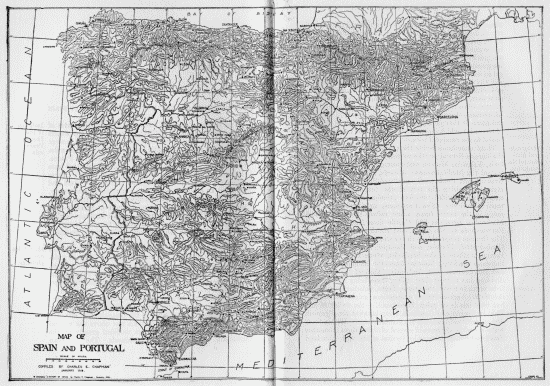A HISTORY OF SPAIN

[larger view] (227kb)
[largest view] (845kb)
![]()
THE MACMILLAN COMPANY
NEW YORK BOSTON CHICAGO DALLAS
ATLANTA SAN FRANCISCO
MACMILLAN & CO., Limited
LONDON BOMBAY CALCUTTA
MELBOURNE
THE MACMILLAN CO. OF CANADA, Ltd.
TORONTO
A HISTORY OF SPAIN
FOUNDED ON THE
HISTORIA DE ESPAÑA Y DE LA CIVILIZACIÓN ESPAÑOLA
OF RAFAEL ALTAMIRA
BY
CHARLES E. CHAPMAN, PH.D.
ASSISTANT PROFESSOR OF HISTORY
IN THE UNIVERSITY OF CALIFORNIA
New York
THE MACMILLAN COMPANY
1918
All rights reserved
Copyright, 1918,
By THE MACMILLAN COMPANY.
Set up and electrotyped. Published October, 1918.
Norwood Press
J. S. Cushing Co.—Berwick & Smith Co.
Norwood, Mass., U.S.A.
TO MY SON
SEVILLE DUDLEY CHAPMAN
BORN IN THE CITY WHOSE NAME
HE BEARS
PREFACE
THE present work is an attempt to give in one volume the main featuresof Spanish history from the standpoint of America. It should servealmost equally well for residents of both the English-speaking and theSpanish American countries, since the underlying idea has been thatAmericans generally are concerned with the growth of that Spanishcivilization which was transmitted to the new world. One of the chieffactors in American life today is that of the relations betweenAnglo-Saxon and Hispanic America. They are becoming increasinglyimportant. The southern republics themselves are forging ahead; on theother hand many of them are still dangerously weak, leaving possibleopenings for the not unwilling old world powers; and some of the richestprospective markets of the globe are in those as yet scantily developedlands. The value of a better understanding between the peoples of thetwo Americas, both for the reasons just named and for many others,scarcely calls for argument. It is almost equally clear that one of theessentials to such an understanding is a comprehension of Spanishcivilization, on which that of the Spanish American peoples so largelydepends. That information this volume aims to provide. It confinesitself to the story of the growth of Spanish civilization in Spain, butits ultimate transfer to the Americas has been constantly in thewriter’s mind in the choice of his material, as will appear from thefrequent allusions in the text. An attempt is made to treat Spanishinstitutions not as static (which they never were) but in process ofevolution, from period to period. The development of Spanishinstitutions in the colonies and the later independent states, it ishoped, will be the sub